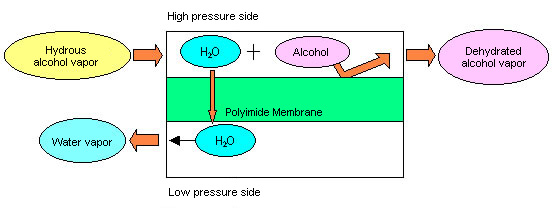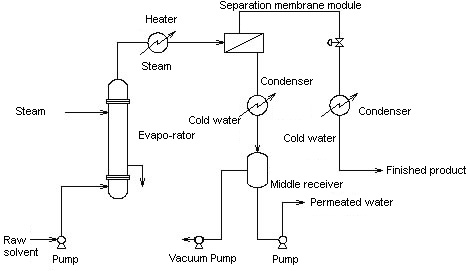Great attention is recently being paid to global environmental issues, and it is now conceivable that companies will need to treat used solvents themselves. In consideration of this kind of social issue, we have developed a “membrane separation type solvent dehydration system,” which uses a polyimide membrane with superior dehydration properties developed by Ube Industries, Ltd. in combination with our own distillation and concentration technology that has resulted in solvents being more easily recovered.
1. Even with azeotropic composition in the distillation method, the solvent can be dehydrated easily as it uses membrane to remove vapor.
2. In comparison with the distillation method, it significantly saves on use of steam.
3. Dehydration can take place through merely supplying evaporated vapor to the membrane module and maintaining the differential pressure between the permeable side and the impermeable side.
4. Solvent purity of 99.9% or more can be achieved by the dehydration with a polyimide membrane only.
5. The polyimide membrane has superior heat and solvent resistance while the vapor permeation method reduces contamination of the membrane and thus extends its life.
The aromatic polyimide membrane is highly permeable to water vapor but less permeable to vapors of organic compounds such as alcohol. These characteristics are used when dehydration takes place.


1. Recovery of detergent solvent: Recovering cleaning solvent used in the electronic parts and precision machinery industries.
2. Recovering and refining of solvent: Recovering and refining solvents used in the chemical, pharmaceutical, food and fermentation industries.
- 1. Acetone
- 2. Ethanol
- 3. Methyl ethyl ketone
- 4. Butanol
- 5. Isopropyl alcohol
- 6. Ethyl acetate
- 7. Methyl isobutyl ketone
- 8. Others (including hexane and toluene)









